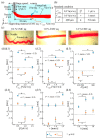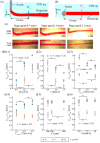4D Printing of Multi-Hydrogels Using Direct Ink Writing in a Supporting Viscous Liquid
- PMID: 31262078
- PMCID: PMC6680559
- DOI: 10.3390/mi10070433
4D Printing of Multi-Hydrogels Using Direct Ink Writing in a Supporting Viscous Liquid
Abstract
We propose a method to print four-dimensional (4D) stimuli-responsive hydrogel structures with internal gaps. Our 4D structures are fabricated by printing an N-isopropylacrylamide-based stimuli-responsive pre-gel solution (NIPAM-based ink) and an acrylamide-based non-responsive pre-gel solution (AAM-based ink) in a supporting viscous liquid (carboxymethyl cellulose solution) and by polymerizing the printed structures using ultraviolet (UV) light irradiation. First, the printed ink position and width were investigated by varying various parameters. The position of the printed ink changed according to physical characteristics of the ink and supporting liquid and printing conditions including the flow rates of the ink and the nozzle diameter, position, and speed. The width of the printed ink was mainly influenced by the ink flow rate and the nozzle speed. Next, we confirmed the polymerization of the printed ink in the supporting viscous liquid, as well as its responsivity to thermal stimulation. The degree of polymerization became smaller, as the interval time was longer after printing. The polymerized ink shrunk or swelled repeatedly according to thermal stimulation. In addition, printing multi-hydrogels was demonstrated by using a nozzle attached to a Y shape connector, and the responsivity of the multi-hydrogels to thermal-stimulation was investigated. The pattern of the multi-hydrogels structure and its responsivity to thermal-stimulation were controlled by the flow ratio of the inks. Finally, various 4D structures including a rounded pattern, a spiral shape pattern, a cross point, and a multi-hydrogel pattern were fabricated, and their deformations in response to the stimuli were demonstrated.
Keywords: 3D printing; 4D printing; stimuli-responsive hydrogel.
Conflict of interest statement
The authors declare no conflict of interest.
Figures









Similar articles
-
Direct Ink Writing Based 4D Printing of Materials and Their Applications.Adv Sci (Weinh). 2020 Jun 29;7(16):2001000. doi: 10.1002/advs.202001000. eCollection 2020 Aug. Adv Sci (Weinh). 2020. PMID: 32832355 Free PMC article. Review.
-
Jammed Microgel-Based Inks for 3D Printing of Complex Structures Transformable via pH/Temperature Variations.Macromol Rapid Commun. 2022 Oct;43(19):e2200271. doi: 10.1002/marc.202200271. Epub 2022 Jun 23. Macromol Rapid Commun. 2022. PMID: 35686322
-
Formulation of Sugar/Hydrogel Inks for Rapid Thermal Response 4D Architectures with Sugar-derived Macropores.Sci Rep. 2020 May 5;10(1):7527. doi: 10.1038/s41598-020-64457-8. Sci Rep. 2020. PMID: 32371928 Free PMC article.
-
Engineered Shape-Morphing Transitions in Hydrogels Through Suspension Bath Printing of Temperature-Responsive Granular Hydrogel Inks.Adv Mater. 2024 Nov;36(47):e2410661. doi: 10.1002/adma.202410661. Epub 2024 Oct 2. Adv Mater. 2024. PMID: 39358935
-
Composite Inks for Extrusion Printing of Biological and Biomedical Constructs.ACS Biomater Sci Eng. 2021 Sep 13;7(9):4009-4026. doi: 10.1021/acsbiomaterials.0c01158. Epub 2020 Nov 10. ACS Biomater Sci Eng. 2021. PMID: 34510905 Review.
Cited by
-
Leveraging ultra-low interfacial tension and liquid-liquid phase separation in embedded 3D bioprinting.Biophys Rev (Melville). 2022 Sep 28;3(3):031307. doi: 10.1063/5.0087387. eCollection 2022 Sep. Biophys Rev (Melville). 2022. PMID: 38505275 Free PMC article. Review.
-
Plant Nanomaterials and Inspiration from Nature: Water Interactions and Hierarchically Structured Hydrogels.Adv Mater. 2021 Jul;33(28):e2001085. doi: 10.1002/adma.202001085. Epub 2020 Jun 14. Adv Mater. 2021. PMID: 32537860 Free PMC article. Review.
-
Synthetic Polymers for Organ 3D Printing.Polymers (Basel). 2020 Aug 7;12(8):1765. doi: 10.3390/polym12081765. Polymers (Basel). 2020. PMID: 32784562 Free PMC article. Review.
-
Freeform 3D printing of vascularized tissues: Challenges and strategies.J Tissue Eng. 2021 Nov 29;12:20417314211057236. doi: 10.1177/20417314211057236. eCollection 2021 Jan-Dec. J Tissue Eng. 2021. PMID: 34868539 Free PMC article. Review.
-
Freeform 3D printing of soft matters: recent advances in technology for biomedical engineering.Biomed Eng Lett. 2020 Sep 29;10(4):453-479. doi: 10.1007/s13534-020-00171-8. eCollection 2020 Nov. Biomed Eng Lett. 2020. PMID: 33194241 Free PMC article. Review.
References
-
- Momeni F., M.Mehdi Hassani.N. S., Liu X., Ni J. A review of 4D printing. Mater. Des. 2017;122:42–79. doi: 10.1016/j.matdes.2017.02.068. - DOI
-
- Ding H., Zhang X., Liu Y. Review of mechanisms and deformation behaviors in 4D printing. Int. J. Adv. Manuf. Technol. 2019:1–17. doi: 10.1007/s00170-019-03871-3. - DOI
-
- Kuang X., Roach D.J., Wu J., Hamel C.M., Ding Z., Wang T., Dunn M.L., Qi H.J. Advances in 4D Printing: Materials and Applications. Adv. Funct. Mater. 2019;29:1–23. doi: 10.1002/adfm.201805290. - DOI
-
- Zhang Z., Demir K.G., Gu G.X. Developments in 4D-printing: A review on current smart materials, technologies, and applications. Int. J. Smart Nano Mater. 2019:1–20. doi: 10.1080/19475411.2019.1591541. - DOI
-
- Pei E. 4D printing: Dawn of an emerging technology cycle. Assem. Autom. 2014;34:310–314. doi: 10.1108/AA-07-2014-062. - DOI
Grants and funding
LinkOut - more resources
Full Text Sources

